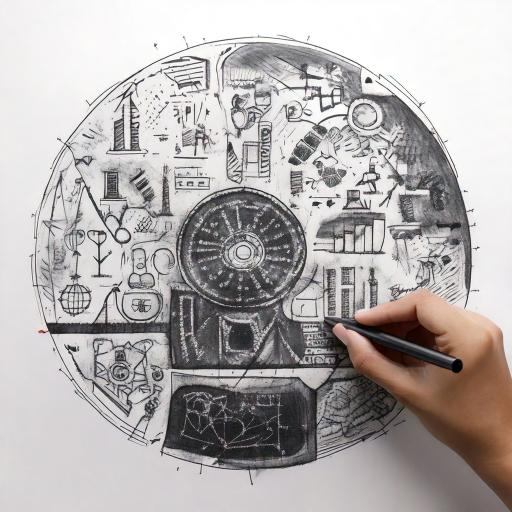Articles
All capability communication development diversity equity and inclusion goal setting inclusive language leadership leading change learning storytelling unconscious bias use cases
-

The Talent vs. Effort Debate
Why Persistence Beats Natural Talent: A Neuroscientific Perspective on Learning. For centuries, people have debated the roles of talent and effort in success. Is genius innate, or is it developed? Are some people simply born with abilities the rest of us can never attain, or is expertise within reach through dedication and persistence?While it’s undeniable that…
-

Learning faster
Want to Learn Faster? Teach Someone Else! The Surprising Way Teaching Others Helps You Learn. Have you ever noticed that explaining something to someone else makes you understand it better yourself? Maybe you’ve helped a friend with a tricky subject and suddenly realized you grasp it more clearly than before. This isn’t just a coincidence—it’s backed by…
-

Part 3: New Leadership Skills
Emerging Skills – New Competencies for the Future. The future of leadership is taking shape in an environment marked by unprecedented technological advancements, societal shifts, and complex global challenges. To thrive, leaders must move beyond timeless and evolving skills to embrace entirely new competencies. These emerging skills—Ethical Foresight, Agile Leadership, Deep Work, and Empathy-Driven Innovation—represent the…
-

Part 2: Evolving Leadership Skills
Timeless Qualities with New Applications. Leadership is a dynamic art—constantly evolving to meet the demands of a rapidly changing world. In this series, we explore how leaders can future-proof their skills to navigate an era of unprecedented change. While foundational leadership qualities—such as effective communication, adaptability, and strategic thinking—remain vital, the contexts in which they are…
-

Future Leadership Skills Series
Skills for the Decade Ahead. The next decade will usher in profound changes that demand a reimagining of leadership. Technological advancements such as artificial intelligence (AI), increasing global interconnectedness, and a pressing need for sustainability and ethical accountability will redefine how leaders operate. The challenges ahead will require leaders to balance timeless principles with innovative…
-

Mindset #6: Relationship Building
The Path to Operational Excellence: Bringing the Mindset Shifts Together. In this series, we’ve explored the mindset shifts necessary for leaders to drive operational excellence. Each shift challenges traditional views on training and development, emphasising the need to prioritise continuous learning, system improvements, and relationship-building. Let’s revisit each mindset shift and then dive deeper into the…
-

Mindset #5: Analysing the system
From Blaming Employees to Analysing the System. When employees fail to meet expectations, it’s easy for leaders to assume the problem lies with the employee’s motivation or effort. This assumption, however, overlooks the bigger picture: organisational systems, processes, and leadership support often play a significant role in employee performance. In this next article in our series…
-

Mindset #4: Continuous Learning
From One-Time Training to Continuous Development. In our previous article, we discussed the critical importance of moving from implicit expectations to clear, documented standards. While establishing clear standards sets the foundation for success, there’s another mindset shift that leaders must embrace for true operational excellence: the transition from one-time training to continuous development.Many leaders mistakenly…
-

Mindset #3: Setting Clear Standards
How Clear Standards Drive Performance Many leaders believe that once employees complete training or have been in a role for some time, they should instinctively understand what is expected of them. This assumption can lead to serious gaps in performance and development. Without clear, documented standards and regular feedback, employees often find themselves navigating a fog…
-

Mindset #2: Leader-Ownership
From Delegating Development to Owning ItThis is the second article in our leadership series, focusing on shifting your mindset from delegating team development to owning it. In the previous article, we discussed the importance of moving from a reactive to a proactive approach in developing people. Today, we’ll delve into how personal involvement in team…
-

Mindset #1: Rethinking underperformance
Operational Excellence Starts with People DevelopmentMany leaders recognise that people development is important, yet they often struggle to fully integrate it into their daily operations. In this series, we’ll explore six key mindset shifts that leaders can adopt to make people development a core driver of operational excellence. Each article will take a deep dive…
-

Driving Organisational Change
Why Investing in Software Is Critical for Successful Organisational Change. Many leaders anticipate change initiatives to fail. If their first attempt at transformation stalls, they often resort to manual, time-consuming steps that only add to the cognitive burden on employees. Instead of investing in tools that could facilitate the transition, they opt for spreadsheets or paper-based…
-

Making feedback count
Feedback That Fuels Success: Mastering the SBI Framework for Powerful Development. “Thanks. Love your work.”Praise like this feels good in the moment, but what comes after? Was it your attention to detail? Your creative solution? Without specifics, praise like this is a flashlight with no batteries—it illuminates nothing about what you did right or how to…
-

Leading Teams
From Good to Great: The Difference Between Managing and Developing Teams As a leader, if you’re not actively developing your team’s capabilities, you’re not just falling behind—you’re leaving growth, innovation, and competitive advantage on the table.While managing focuses on the execution of day-to-day tasks, development-oriented leadership aims to cultivate the long-term skills and capabilities of individuals…
-

Understanding Power Dynamics
Comprehensive Guide to Understanding and Effectively Using Power Dynamics in Management. Power dynamics are a crucial aspect of leadership, affecting everything from decision-making to team morale and performance. For many managers, especially those who have struggled with demonstrating power, it can be difficult to navigate these dynamics effectively. This guide is designed to help managers not…
-

Using Data in Feedback
Feedback Companion Guide: Using Data and Multiple Perspectives When Delivering Feedback. This guide helps managers deliver well-rounded, objective, and actionable feedback by incorporating data and multiple perspectives. It encourages thoughtful reflection on performance, ensuring feedback is both constructive and based on a comprehensive understanding of the employee’s contributions and challenges. Section 1: Why Use Data and Multiple…
-

Cultural Competency Guide
Feedback Companion Guide: Culturally sensitive and respectful communication. In today’s globalised workplace, cultural sensitivity is no longer a soft skill—it’s a critical component of effective management and leadership. The way people communicate, interpret feedback, and engage with one another is deeply influenced by their cultural backgrounds. As organisations become more diverse, managers must develop the ability…
-

Bias Mitigation Checklist
A Comprehensive Checklist for Preparing and Delivering Fair FeedbackThis checklist is designed to help managers ensure their feedback is free from bias, both during preparation and reflection. Use this tool to review your feedback and assess for potential biases that could distort your evaluation.Preparation: Before Giving FeedbackEvaluate Based on Objective Criteria:Have I reviewed clear, measurable…
-
Identifying and Mitigating Bias
Identifying and Mitigating Bias in Feedback: A Companion Guide for ManagersIntroduction: Understanding Bias in FeedbackFeedback is an essential tool for employee development, but when biased, it can distort perceptions and negatively impact both performance and relationships. Biases are cognitive shortcuts our brains use to process information quickly. While they can be useful for decision-making in…
-
Navigating Emotional Reactions
A Comprehensive Guide for ManagersWhen managers provide feedback, particularly in challenging conversations, emotional reactions are inevitable. Emotions such as fear, anxiety, anger, sadness, or even shame can arise. It’s crucial for managers to remain calm, empathetic, and supportive during these moments. This guide provides step-by-step strategies to help managers navigate emotional reactions effectively.Navigating Emotional ReactionsManaging…
-
Setting Objective Standards
Why Unwritten Standards Cause Issues and How to Address ThemUnwritten standards in performance management are a common pitfall in many organisations. Although they may seem benign, failing to document and communicate clear performance expectations can lead to significant challenges. Here’s a deeper look into why unwritten standards can cause issues, how they affect management and…
-
Feedback Frequency
Feedback Frequency and Impact: What Research Reveals and Best Practices for ManagersProviding feedback is a crucial part of managing and developing teams, but how often should you offer it? The answer isn’t one-size-fits-all. Research and best practices suggest that feedback frequency plays a significant role in enhancing employee performance, engagement, and growth. Here’s a closer…
-
Building A Feedback Culture
A Manager’s Guide to Building a Feedback CultureIntroductionBuilding a feedback culture is essential to fostering a productive and high-performing workplace. Feedback is not just about correcting mistakes; it’s about continuous improvement, development, and creating an environment where everyone feels safe to share and receive constructive insights.A strong feedback culture promotes open communication, accountability, and mutual…
-
Assessing Employee Receptivity
How to Determine if Your Employee is Ready to Receive Feedback. Determining if an individual is mentally and emotionally ready to receive feedback is crucial for ensuring the feedback is effective and constructive. If a person isn’t ready, delivering feedback might result in misunderstandings, defensiveness, or even damage to the relationship. Here’s how a leader can…
-
Giving Time Critical Feedback
Guidance for Urgent or Immediate FeedbackThere are times when feedback cannot wait—perhaps due to a critical incident, an urgent performance issue, or a situation that requires immediate correction. While the ideal scenario allows for careful consideration of timing and setting, urgent feedback demands prompt action. However, it’s still essential to deliver the feedback in a…
-
Assessing Workload
Guidance Sheet: How to Assess an Employee’s Workload Before Giving FeedbackAssessing an employee’s current workload is a critical component of evaluating their readiness to receive feedback.When assessing workload, it’s important to think about both the volume of work and the emotional demands of the tasks the employee is currently handling. Feedback, while valuable, can add…
-
Assessing Feedback Readiness
Detailed Guide Sheet: Evaluating Timing, Setting, and Appropriateness for FeedbackEffective feedback is a powerful tool for growth and development, but its impact depends significantly on when, where, and how it is delivered. This guide is designed to help leaders, whether new or experienced, assess the timing, setting, and appropriateness of their feedback to ensure it…
-
Skills and Performance Reviews Matter
Why Continual Skill and Performance Reviews Matter—Even for the Most Experienced OperatorsThe Experience Paradox: Staying Current in a Changing LandscapeAs an experienced professional, your skills and knowledge are invaluable. You’ve honed your expertise over years, perhaps decades, and you’ve seen what works and what doesn’t. However, the business landscape is constantly evolving. What was effective…
-
Developing your skills
Developing your skillsIn today’s rapidly evolving professional landscape, continuous skill development is not just an option—it’s a necessity. Whether you’re a seasoned professional or just starting out, the benefits of honing your skills are plentiful. This article explores why developing your professional skills is crucial, how it can benefit you and your team, and practical…
-
How to Give Actionable Feedback to Employees: A Guide for Managers
Feedback is a vital tool for employee development, performance improvement, and organizational growth. However, not all feedback is created equal. To be truly effective, feedback must be actionable—meaning it should provide clear guidance that helps employees understand what they need to do differently or continue doing to succeed.In this article, we’ll explore the key principles…
